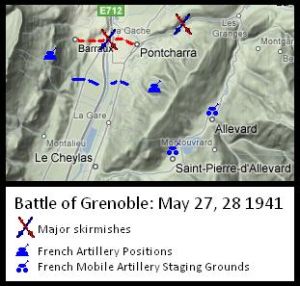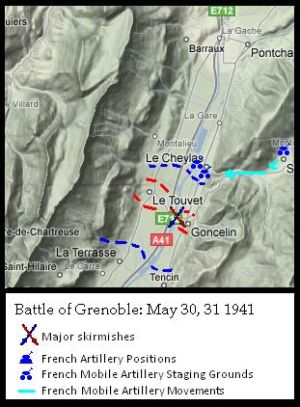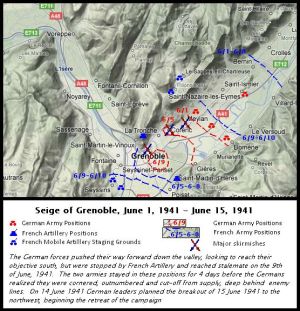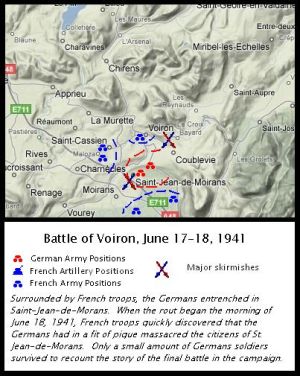Battle for Grenoble
The three week Battle for Grenoble proved to resemble the French Stalemate in microcosm, as the French forces and German forces exchanged blows up and down the long valley to the East of Grenoble. The end result was the defeat of the German forces who retreated to their territory in Helvetia by way of Voiron, where the final battle of the Alpine Pinch was fought.
May 27 - 29
Arriving in the long valley above Grenoble at the line from Barraux and Pontcharra on May 27, 1941, the Germans came under artillery fire from Gaulish forces, and were forced to take cover. Rather than pummel them out with artillery, the French Armies moved in snipers to further demoralize the German forces. A furtive move up a canyon to the east to bypass the entrenched artillery was foiled by a French induced land-slide, blocking the only passable road up that canyon. The only other bypass would be backtracking for the better part of a day.
Reconnaissance by German soldiers indicated the movement of the French Army from the west to flank them at the north-east end of the long valley. The German leadership decided to push forward down the valley, capturing, the French Artillery if possible, or destruction if necessary. A radioed communique for Luftwaffe support went unanswered due to poor planning and poor weather at Geneva.
By the evening of May 28, 1941, 14 officers had been killed, 3 wounded, and countless infantry. When reconnaissance groups returned they informed the German leaders that this was the final outpost before Grenoble, and that if they could break through, they would have a straight-shot through Grenoble, and onward, achieving their objective.
The night of May 28th, 1941, German special ops were deployed to take or destroy the entrenched artillery on the mountain slope while the rest of the army moved south-west toward Grenoble. The two entrenched artillery to the east and west of the valley were destroyed by German forces in the night, and the Germans moved successfully to La Gare and just north-east of Montalieu by daybreak.
It was discovered that the French forces had erected a series of trenches just south of Montalieu extending from Montalieu to Le Touvet, and the mountains between Saint-Pierre-d'Allevard and Theys were impassable to all but foot-soldiers. By dusk the German forces began massing their tanks for a Blitzkrieg run against the French trenches, only to discover that the French had abandoned the trenches and retreated to La Terrasse some miles south.
May 30 - 31
On the morning of May 30th, German forces occupied Goncelin and moved south against Tencin and La Terrasse. By noon, the Germans had come under fire, as French mobile artillery and troops had moved from their hidden staging grounds in Saint-Pierre-d'Allevard and Allevard. These were backed up by the arrival of a small battalion of French reinforcements, and the Germans were again pinned down, and subject to sniper attack.
German reconnaissance lead them to believe that the French forces now centered in La Terrasse and Tencin were weaker than those that had moved in behind to occupy Le Cheylas, blocking a retreat to Helvetia. An all out assault was launched on La Terrasse and Tencin, and the French retreated, while the battalion and artillery of Le Cheylas remained silent.
The Germans moved further southeast, wishing both to get out of the meat grinder, but also to achieve their directive of the Alpine Pinch. Inital reports of artillery above Grenoble and St.-Martin-d'Hères were believed to be French propaganda, and in their bluster, the German leadership discounted the feedback from some of their vanguard troops.
June 1 - 15
The German armies became entrenched at Saint-Nazaire-les-Eymes and along a line from Meylan to Domène from June 1 through June 4. The German leadership expected air support at any time to help remove the pounding artillery staged Grenoble and St.-Martin-d'Hères. The French army to their rear used primarily guerrilla tactics, and served largely to block the Germans from their supply train which was being successfully held near the Helvetian border.
Desperate to quit the tactics facing them, the German armies pushed forward from June 5 to June 9, initially securing a line from Corenc to Gières. As they consolidated in Corenc, mobile artillery from Pillionières and Le Sappey-en-Chartreuse began attacking and the army moved into the downtown area of Grenoble, erecting barricades and taking refuge in the Mairie and other targets that would otherwise be deemed unconscionable for assault by the artillery that now surrounded them, at Grenoble and St.-Martin-d'Hères, Seyssins, Corenc and La Tronche.
Fighting a war of attrition, the German leadership realized the depth of their failure, and on June 14th planned their breakout, leaving two armies to fight a rearward guard as they moved northwest to the city of Voiron.
June 17 - 18
German leadership by June 16 was fragmented and largely dead. With junior commanders taking charge, the army entrenched at St.-Jean-de-Moirans. Most of the population scattered, however. The few that remained in the city were rounded up the night of June 16 and summarily executed in the central plaza.
French troops, hearing the gunfire suspected the worst and raised the attack early on the morning of June 17, 1941. The battle quickly degenerated into a rout and the surviving German troops fled northeast to Helvetia. French rear-guard action in Chambéry and other cities decimated the German troops and only a handful were reported to return to the Helvetian division's headquarters.
A monument was erected in the central plaza for the victims of the massacre and a street was named in their honor, "Rue des Patriots".



